Jige
A jige (Korean: 지게) is a traditional Korean tool used to carry large quantities of heavy materials. The tool was often used in agricultural communities to facilitate the transportation of large quantities of materials such as compost, grain, wood, and grass. Its design varied depending on the region.[1] A jige is easy to make and has been used extensively due to the mountainous terrain of Korea.[2]
 | |
| Classification | Korea traditional tool |
|---|---|
| Types | Carrying by back |
| Used with | To lift luggage |
| Model | Diverse |
| Jige | |
| Hangul | |
|---|---|
| Hanja | |
| Revised Romanization | Jigeh |
| McCune–Reischauer | Chige |
Americans called the tool A-frame during the Korean War.
History
The word jige was first used by Jeong Cheol (1536–1593) during the Joseon Dynasty and is mentioned in books from the late 17th to the middle 19th century. In 1905, according to the Korea Land and Agriculture Research Report, jige are also called jigi and damje.[3]
They were still widely used in rural areas during the 1950–1953 Korean War. American soldiers dubbed them "A-frames", as their general shape resembles the upper-case letter A.[4]
Part
The jige is made of the following parts:[5]
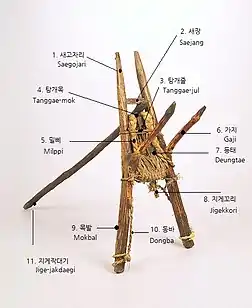
- Saegojari (Korean: 새고자리): the narrow top.
- Saejang (Korean: 새장): a piece of wood that is cut across the base so that its two pairs are woven together. There are usually four or five cages. The top cage is called the whit-saejang or the kkamak-saejang.
- Tanggae-jul (Korean: 탕개줄): a rope wrapped around the jige's body to prevent it from falling apart. The woodcutter can hang a sickle on it.
- Tanggae-mok (Korean: 탕개목): a piece of wood kept in place by the tanggae-jul.
- Milppi (Korean: 밀삐): a strap with straw. It is tied to the milppi-saejang and mokbal.
- Gaji (Korean: 가지): a wooden protrusion that supports the load. It is angled upwards from the jige's body.
- Deungtae (Korean: 등태): a spot on the back of the peg that is tied with straw.
- Jigekkori (Korean: 지게꼬리): a string that is tied onto the jige. It is also called jikkori.
- Mokbal (Korean: 목발): the bottom of the jige. It is also called the dong-bal.
- Dongba (Korean: 동바): a string that is tied to a mokbal to support a load.
- Jige-jakdaegi (Korean: 지게작대기): A piece of wood that is loosely attached. It is used to set up a jige,[6] and is also used as a walking stick to climb a slope with a jige and navigate through the grass.
Dialect of part
The parts of a jige are named differently according to the regional dialects of Korea.[5]
| Standard / Area[5] | Banwol, Gyeong-gi | Deokjeok Gyeong-gi | Bongyang, Choung-buk | Yeongsan, Kyeong-nam | Jangheung, Jeon-nam | Dogye, Gang-won |
|---|---|---|---|---|---|---|
| Saegojari
(새고자리) |
Saedeumeori
(새드머리) |
Saemeori
(새머리) |
Saeppul
(새뿔) |
Kkamukdori
(까묵도리) |
Kojak
(코작) |
Saeppul
(새뿔) |
| Saejang
(새장) |
Soejang
(쇠장) |
Saemeorisoe
(새머리쇠) |
Saejang
(새장) |
Seojang
(서장) |
Ssejang
(쎄장) |
Sejang
(세장) |
| Gaji
(가지) |
- | - | - | Dwitgaji
(뒷가지) |
Gaji
(가지) |
Gaji
(가지) |
| Deungtae
(등태) |
Deungtae
(등태) |
Deungtae
(등태) |
Deungtae
(등태) |
- | Deungtae
(등태) |
- |
| Mokbal
(목발) |
- | - | Mokbal
(목발) |
Mokbal
(목발) |
Tongbal
(통발) |
Mokdongbal
(목동발) |
| Milppi
(밀삐) |
Milppang
(밀빵) |
Tteulppi
(뜰삐) |
Milppi
(밀삐) |
Mikkeun
(미끈) |
MIppang
(미빵) |
Meppi
(메삐) |
| Tanggae
(탕개) |
Tanggae
(탕개) |
- | Taenggae
(탱개) |
- | Taereunggae
(태릉개) |
Taenggae
(탱개) |
| Tanggaemok
(탕개목) |
Tanggaemakdae
(탕개막대) |
- | Taenggaejakdaegi
(탱개작대기) |
- | Taereunggae
(태릉개) |
Taenggaekkojaengi
(탱개꼬쟁이) |
Principle and effect
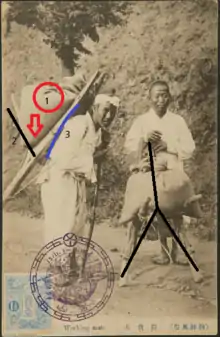
The triangular shape of the jige from its legs and pole create a stable device to carry objects. By using a jige's pole, a person can also reduce the weight of the center of gravity that supports them in a two-machine frame and decrease the magnitude of the force exerted on their legs when standing up. The tanggae and tanggae-mok act like washers to distribute the load's weight evenly. The legs are loosely attached to easily adjust the device according to the carrier's height. If the load becomes heavier, it must be balanced well on the jige and the carrier must walk at a steady rhythm; otherwise, the load cannot be carried.[7]
The principle of the lever applies to the jige: the shoulders and the back of the jige act as a fulcrum so that the force is moved with small force.[8]
Classification
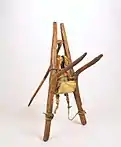
Je-gaji jige
The je-gaji jige (Korean: 제가지지게) is named after the gaji. It needs two pieces of wood that have similar angles, thickness, and location to act as gaji. The length of the jige is usually adjusted to the height of the person who uses it. Je-gaji jige used in plains are longer than those used on mountains, as mountain paths tend to be narrow with a higher risk of the carrier falling down. The narrow upper part of the jige is usually trapezoidal, but some parts of the jige are carved by attaching the top of both sides. The jige's body is made of pine wood. Saejang is made of hard wood, such as a birch or chestnut tree. The shape of deungtae varies by region, and in the mountains and some parts of Gangwon Province, the bottom part of the saejang is widely cut without the deungtae. It is common for the jige to form a trapezoidal shape with its narrow and wide upper parts.[3]
Jjok jige
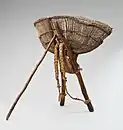
The jjok jige (Korean: 쪽지게) is divided into two types of wood. The carriers try to cut down to get as much weight as possible, and as a result, the length long enough so that they can rest without sitting down on the road.
The jige jakdaegi differs from the standard jige in two ways: the iron stick is (known as the chok jakdaegi) is inserted at the end of the jakdaegi to prevent the carrier from sliding on icy roads and intimidate animals, and the notch in the middle of the top supports the jakdaegi on the jige when a person stands and rests.
Jjok jige in North Jeolla Province is made from cowhide, oak, and acacia trees. It is constructed by cutting down trees and twisting them between the body and gaji.[3]
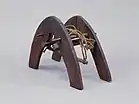
Geo jige
The geo jige (Korean: 거지게) is a very short jige with two or three saejang. The gaji are almost perpendicular to each other, and there is also a horizontal piece of wood to prevent the load from falling. It is usually used on the back of a cow.[3]
Ba jige
The ba jige (Korean: 바지게) was used by carriers who traveled inland from the coast of some parts of northern and southern Gyeongsang Province through the mountains. It is usually made from paddock wood. Ba jige does not have gaji.
The ba jige is set up as two long sticks in the shape of an A and placed horizontally in the middle to make the first saejang. Two sticks are connected between the left and right ends to form a triangle. At the base of this triangle, the stick is placed above the apex and replaced with a second saejang. There are no deungtae.[3]
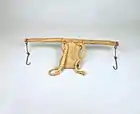
Mul jige and georeum jige
The mul jige (Korean: 물지게) and georeum jige Korean: 거름지게 (or ddong jige) are the same device used to carry buckets; it is called the mul jige when carrying buckets of water and georeum jige when carrying fertiliser.[3] Its back uses a wide range of wood. A pole rests horizontally on the carrier's shoulder to carry the buckets on both ends, and is designed to prevent the contents from splashing onto their clothes.[9][10]
Other countries
China
The Chinese variant is called the bei-jia, and is used in the northern mountains of Hubei and Shanxi, China. The difference between China's and Korea's is the presence of a gaji.[11]
Taiwan
Taiwan's version is fixed by hanging four saejang between two round pieces of wood. The second saejang is tied to both sides and the rope is horizontally tied to the forehead. This method has been used in Taiwan, Nepal, northern Thailand, and southern Japan.[11]
Thailand
Minorities in northwestern Thailand also use a jige-like tool. It uses three saejang stacked between two long open pieces of wood. The second and third saejang serves as the back of the device and is fitted with two boards.[11]
North America
Among the natives of North America, the Pima people and Papago tribe used tools called kihos, which consists of a conical bowl, a cactus stick, deungtae, a forehead string, and sticks.[11]
Japan
In Japan, there is a transportation tool called kago, which is a bamboo basket used to carry people, especially in mountainous regions. It involved a small litter that can hold one individual and is suspended by a pole. It is typically carried by over two men's shoulders. The bamboo basket used in the kago varies and can be used as backpacks or carrying vessels for other objects.[12] The variations depend on the type of weave, like the hip-basket, which has an open weave to allow water drainage or a tight weave to keep loose seeds when transporting grains.[13]
See also
References
- "지게란 무엇인가?" [What is Jige?]. Culturecontent.com (in Korean). KOCCA. Retrieved 2018-04-13.
- 김(Kim), 연태(YeonTae) (2012). "지게에 대한 설명" [Description of Jige] (PDF). www.ekacem.or.kr (in Korean). KACEM.
- 김(Kim), 광언(GwangUn) (1993). "Jige research one". 고문화 (in Korean). 43: 159–191 – via 한국대학박물관협회.
- "[Heroes from afar] Canada answered Korea's call for help, with heroism and hockey sticks". koreajoongangdaily.joins.com. 2020-07-19. Retrieved 2023-09-17.
- "지게 - 한국민족문화대백과사전" [Jige - Encyclopedia of Korean Culture]. encykorea.aks.ac.kr (in Korean). Retrieved 2018-04-13.
- "지게". terms.naver.com (in Korean). Retrieved 2021-04-11.
- "멜빵 문화의 완성작 '지게'" ['Jige' The completed work of suspenders culture] (in Korean). Retrieved 2018-04-13.
- "가장 단순하면서 과학적인 운반 도구 지게의 구조와 원리" [Jige that structures and principles are the simplest and most scientific]. YTN Science (in Korean). Retrieved 2018-04-13.
- 최(Choi), 운식(WunSik) (2007). 한국의 전통 사회 운송 기구 [Korean Traditional Social Transportation Organization] (in Korean). Ewha Womans University Press. pp. 23–31. ISBN 9788973007288.
- "물지게" [Mul Jige]. War Memorial Korea (in Korean). Retrieved 2018-05-31.
- 김(Kim), 광언(GwangUn) (1996). "지게 연구(V) - 나라 밖의 지게" [Research of Jige Five, Outside of Korea]. 고문화 (in Korean). 48: 43–77 – via 한국대학박물관협회.
- Japan Society of London (1893). Transactions and Proceedings, Volume 1. London: William Clowes and sons, Ltd. p. 26.
- Leslie, Albrecht Popiel (1994-12-29). "Japanese Basketmaker Weaves Tradition, Taste, and Function". Christian Science Monitor. ISSN 0882-7729. Retrieved 2018-06-01.
